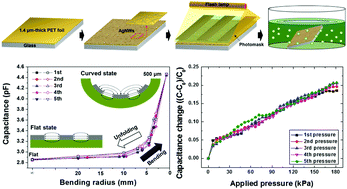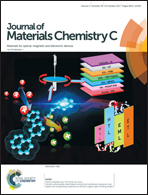Photo-induced fabrication of Ag nanowire circuitry for invisible, ultrathin, conformable pressure sensors†
Abstract
We demonstrate ultrathin (thickness <1.5 μm), transparent (transmittance >88% at 550 nm), and conformable pressure-induced bending sensors with unprecedented flexibility and stretchability, produced by developing a photo-induced pattern of silver nanowires (AgNWs) on a 1.4 μm-thick polyethylene terephthalate (PET) sheet. This patterning approach does not require any additional materials to form a patterned barrier for AgNW etching or to enhance the adhesion between the AgNWs and PET. Simple irradiation using pulsed light on a masked AgNWs/1.4 μm-thick PET assembly followed by sonication formed a finely patterned AgNW network well-adhered to the underlying PET without impacting the optical transparency of the ultrathin PET. A pressure-induced bending-sensitive capacitive sensor fabricated by this approach was extremely flexible and stretch-compatible up to 100% uniaxial strain. This sensor, based on a simple tandem compound pattern, was reproducible, durable, and 90% more sensitive than an elastomeric pressure sensor made using the same sensor design. The functionality of the developed sensor system was successfully demonstrated in a sensitive acupressure sensor mounted on a gloved fingertip, in which the capacitance coincidently varied with the force applied to the fingertip.



 Please wait while we load your content...
Please wait while we load your content...